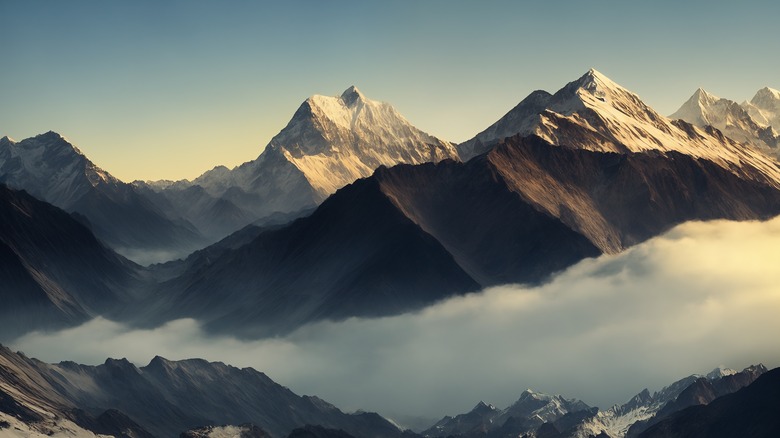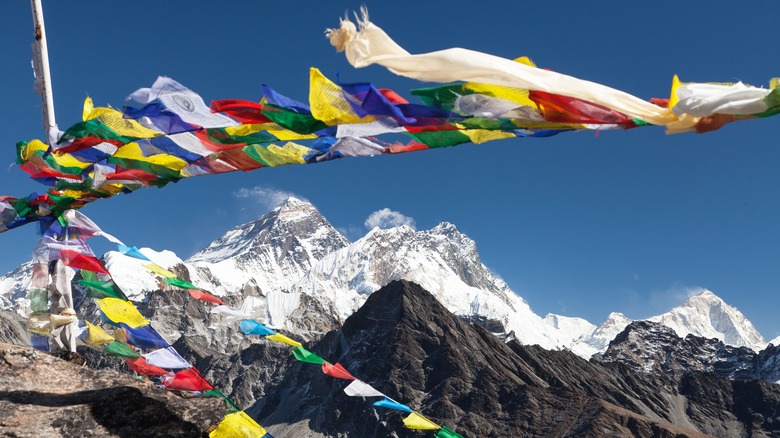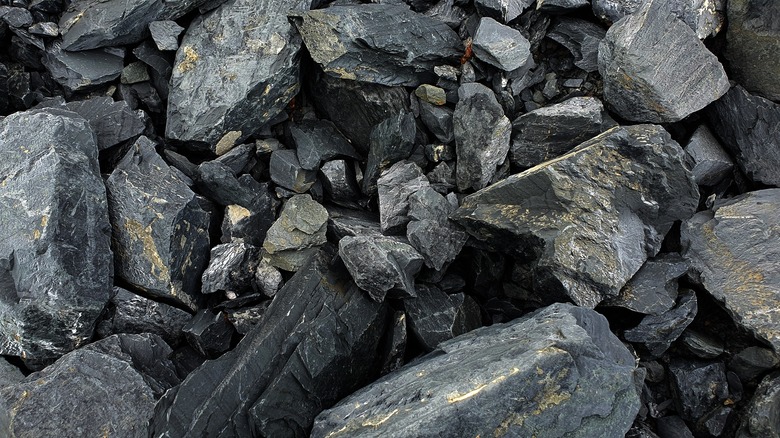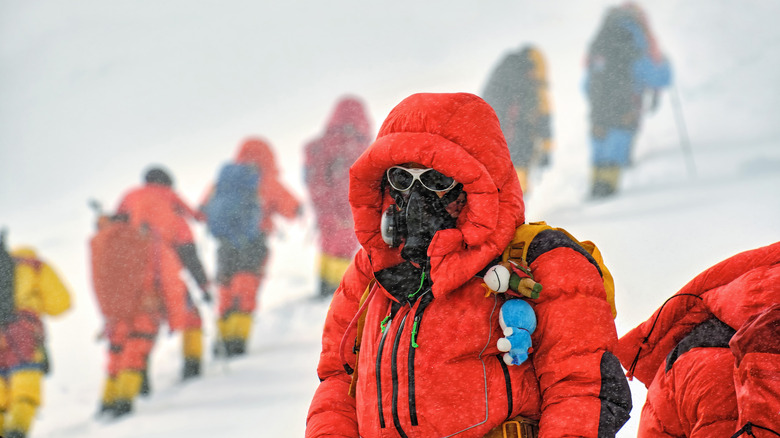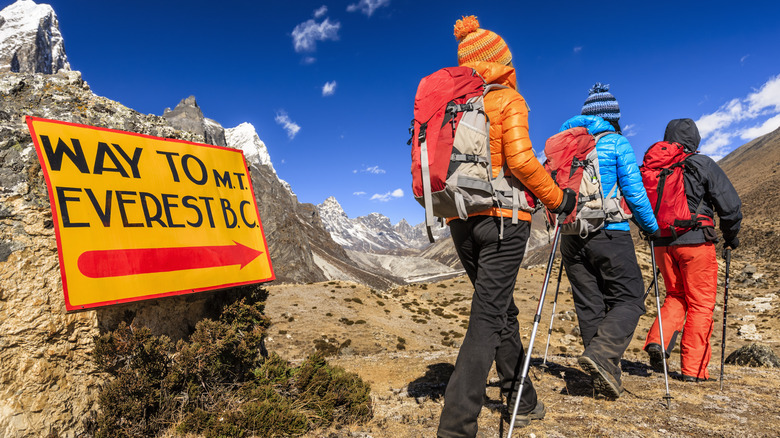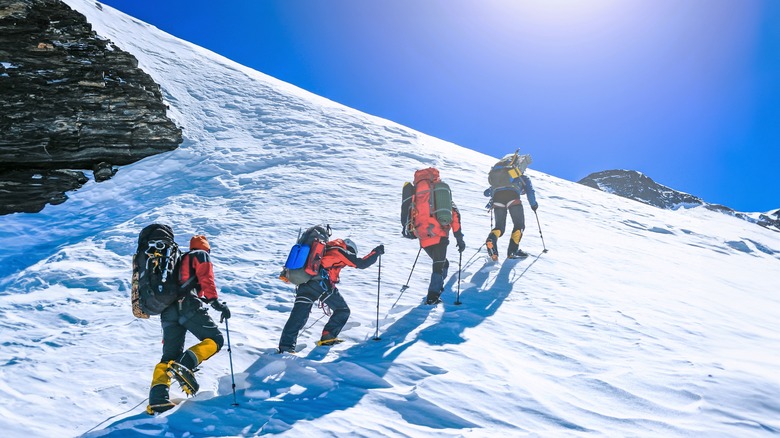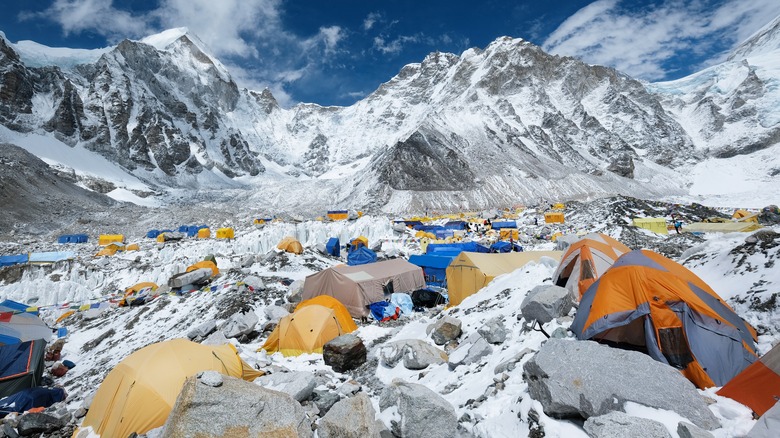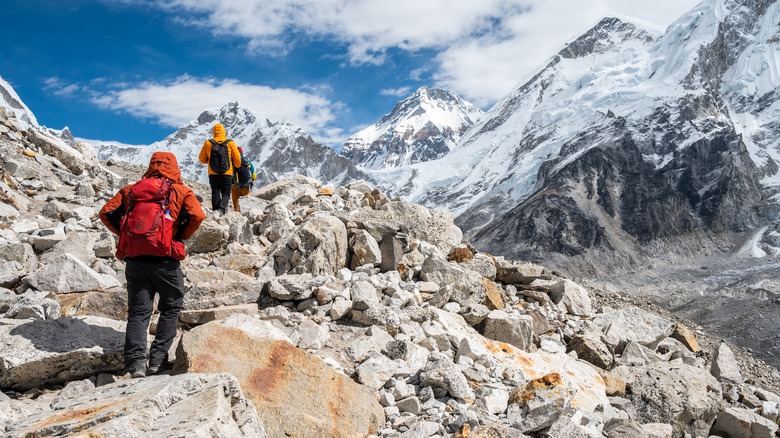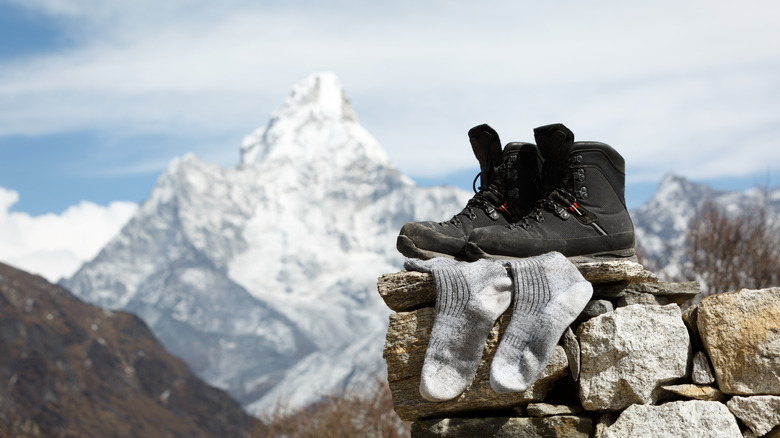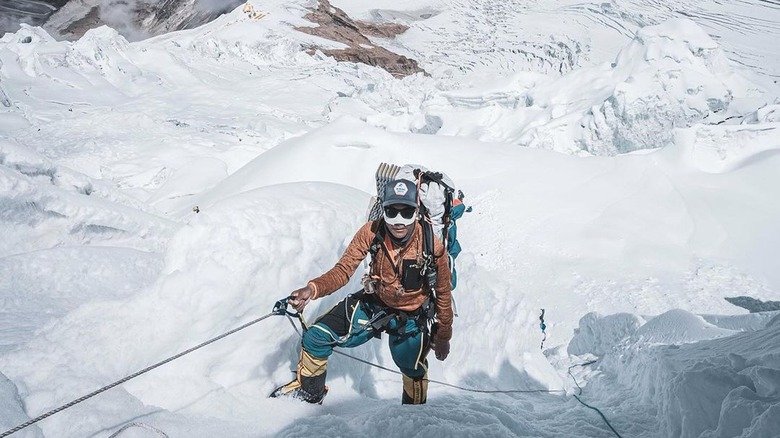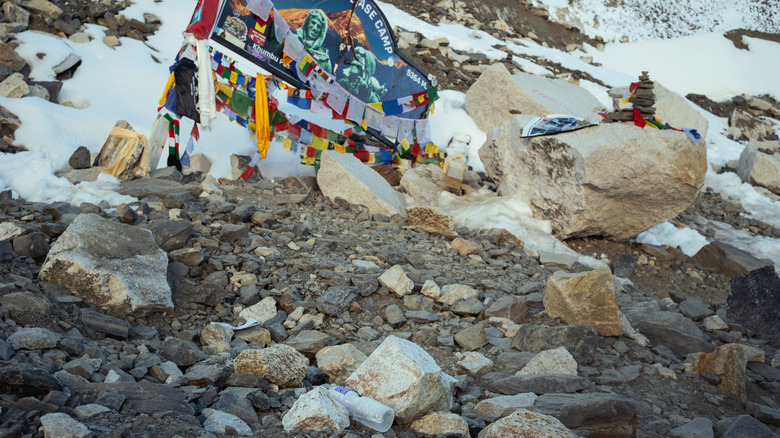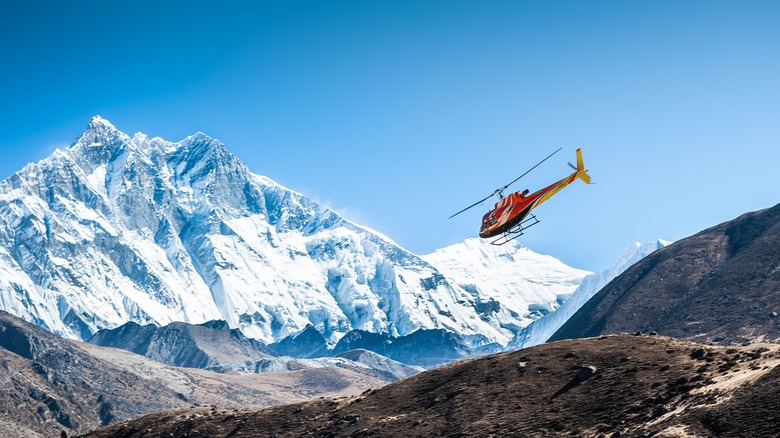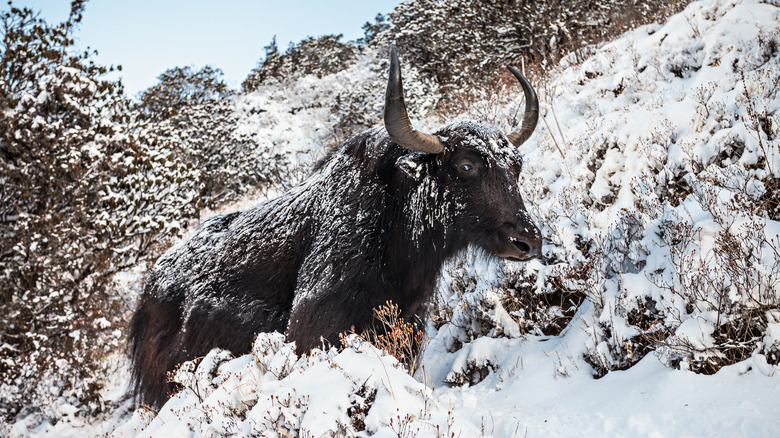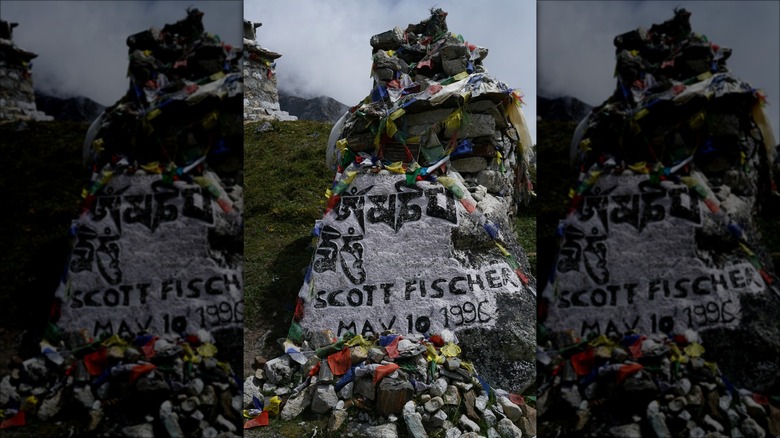The Most Interesting Facts You Don't Know About Mt. Everest
The tallest point on the planet, Mount Everest is a desolate peak that speaks to ultimate adventure. Topping out at a little over 29,000 feet — almost the height that some commercial airplanes cruise at as they zip around the globe — it's a rugged, dangerous peak that thrill seekers and climbers seek to scale as a test of human limitations.
The iconic Mount Everest has entered our collective psyche, and many will be familiar with some of its history and lore. The first recorded summit was in 1953 by the New Zealand climber Sir Edmund Hillary and his guide Tenzing Norgay, and ever since, scaling the mountain has captured the imagination of mountaineers the world over.
Everest is part of the Himalayas, a range created millions of years ago when landmasses collided, and today, it straddles two nations — Nepal to the south and Tibet, an autonomous region of China, to the north. It's a place made famous by feats of daring, and its beauty and menace have been immortalized in books and on celluloid. But for all the facts about the mountain that are now firmly part of popular culture, there are many more tidbits that aren't so well known.
Mt. Everest has a few names
In the Western Hemisphere, most people will know the mountain solely by the name of Everest, but that was only attached to the mountain in 1865 by the British Surveyor General of India, Sir George Everest. Even if for this moniker of the peak, there is some dispute over the correct pronunciation of Everest, with some commentators mentioning the name of the surveyor general, which should be enunciated as two syllables, not three — so "Eve-rest," not "Ev-e-rest." Nevertheless, for the more globally attuned, Everest is not the only way of identifying the highest point on Earth.
The Tibetan people refer to the mountain as Chomolungma, which translates to "Goddess Mother of the World," a name that appeared on a European map of the region in the 1700s. For the Nepalese, the name of the mountain carries a similar sentiment — it's known as Sagarmatha, which means "Goddess of the Sky" or "Head of the Earth touching Heaven." Many Tibetans and Nepalese believe the mountain is sacred, where deities live, which is why climbers will see prayer flags en route and perhaps take part in a blessing ceremony before attempting a summit.
It might be older than you think
The story behind the creation of Everest reaches into the distant past, way, way back. Hundreds of millions of years ago, India was actually an island that sat off the coast of Australia, but about 80 million years back, this isolated plot of land started inching north, slowly and consistently, up toward the Eurasian continent.
Eventually, the two met, clashing with gradual but immense force that, in simple terms, pushed the rock and ocean sediment in between the two upward, creating the Himalayas. According to estimates, the mountain is about 50 million years old, but that doesn't tell the entire story of Mount Everest.
The rock that forms the peak and upper sections of its slopes has a much older provenance, made of Ordovician limestone — which is more than 400 million years old, as reported by the International Commission on Geoheritage. Limestone is commonly found in and around water, and the type on Everest was actually from the shallows, which explains why some of the rocks at the top of the mountain have fossils of creatures that lived in the seas all those millions of years ago, animals like brachiopods and crinoids.
It keeps hitting new highs
While there is some dispute over the exact height of the top of the mountain, with different surveys throwing up statistics that vary by small amounts, the mountain has a commonly accepted height of 29,032 feet above sea level (give or take a few feet!). However, it continues to grow each year, a process caused by the ongoing pushing of the Indian plate against the Eurasian plate.
While this growth isn't visible to the naked eye, the mountain does get marginally taller each year, about 4 millimeters, making Everest a work in motion. And yet, even with these annual increments, it's not technically the tallest mountain in the world. Yes, it tapers to a point that is the highest above sea level on the planet, but in terms of height between the base of the mountain and its peak, a couple of mammoths in Hawaii beat Everest.
Mauna Kea, on the Big Island, was once an active volcano. According to the National Ocean Service, from its base to its crest, the cone is almost 33,500 feet high, but more than half of the mountain is underwater. Also on the Big Island, Mauna Loa, which is still active, rises about 30,000 feet from bottom to top, but again, much of it resides below the ocean.
Everest is fiendishly unpredictable
Anyone who's been on a hike to the top of a hill will recall how the conditions at the summit are often different from those much further down. The air might be cooler, the wind stronger and more constant, and the sun harsher — in essence, the elements are more elemental. At the top of Everest, the weather is brutal; it's cold all year round, with temperatures rarely rising above 3 degrees Fahrenheit. And that's as warm as it gets up there! If the frigid air weren't enough to contend with, the wind is a biting, hurricane force at times, and climbers could easily suffer from frostbite from the wind chill.
And then there is the lack of oxygen at this height, with only about ⅓ of the oxygen at the summit as there is a sea level. This makes any exertion so much more challenging and is one of the reasons why the final part of the ascent to the top might only be about a mile in length but can take many hours (the long queues also don't help). Even on a calm, cloudless day, the weather can capriciously change, and the peak can be smothered in clouds even when the rest of the sky seems clear — this is due to the shape of the mountain, which urges clouds to form where they might not otherwise. Some climbs have to be abandoned due to the weather.
There are many ways to the top
A casual observer might assume that there is one way up to the top of the mountain, in the same way that some hikes follow one trail to reach the summit of a hill or arrive at lofty viewpoint. But the reality is that there are many different routes to the pinnacle of Mount Everest, almost 20 by some counts. That said, two main avenues dominate the ascents made — one from the Nepal side, the other from the Tibet section.
The Southeast Ridge (also known as the South Col) journey begins in the South Base Camp in the Khumbu Valley, a stunning part of Nepal where climbers can enjoy the scenery and simple way of life and also acclimatize to the environment — it's about 17,600 feet above sea level. From here, adventurers will stay in a few camps before the final assault to the summit. The Northeast Ridge Route approaches the mountain from Tibet, with the initial base camp at 17,000 feet and subsequent camps getting increasingly higher. The route a climber chooses is largely a matter of personal preference.
The journey from top to bottom takes a long time
Considering how the mountain was first summited in 1953 and how well the routes to the top are documented, you might think that getting climbers to the top is a slick, well-oiled conveyor belt. Maybe it just requires a speedy overnight excursion from an organized camp or a few hours of trekking starting in the wee hours of the day.
Sadly, or not, none of these is true, and beyond the months of intense training required to get in peak physical shape — not to mention the need to be mentally strong as well — the actual time on the mountain from the beginning trek to the summit and back can take two months. This isn't a casual stroll along the ridge in the Smokies or a day hike in the Colorado Rockies.
The main reason for the extended period of time is the altitude, which travelers must acclimatize to. After the trek to the base camp, climbers need to move up and down between camps of varying heights in order to get used to the air and environment. Only then will they be ready for the final leg of the climb up to the summit. The entire process takes seven to nine weeks for most experienced climbers.
The base camps aren't just for Everest climbers
As mentioned, getting to the peak requires ping-ponging between a number of camps, starting at the base camp, the de facto command center for operations. On the Tibet side of the mountain, the base camp sits at about 17,000 feet, and en route to it from Lhasa, visitors will find places to stay, spots to get a pot of tea, and even a post office. The Nepal side base camp is a few hundred feet higher and is like a small remote settlement with tents and domes dotted around the craggy glacial plateau.
A misconception is the base camps are exclusively the launching pad for climbers who are attempting to ascend Everest, but for some visitors, the base camps are the destination. Some trekkers do what is known as the Everest Base Camp trek, where they walk for days through the mountains to the base camp or around it, drinking in the sublime alpine scenery en route. The Nepal base camp can only be accessed on foot, while the Tibet camp has road access.
Only 15 people have made it to the top during winter
As if the harsh conditions weren't tricky enough, Everest is a mountain that becomes extremely dangerous for many months of the year when the winds pick up to hurricane force, and the mercury can dip as low as -76 degrees Fahrenheit. In fact, only a grand total of 15 people have reached the summit during the winter, as reported by The New York Times.
As such, anyone who plans to attempt a summit of the mountain should wait for the two small windows of opportunity that open in the spring and fall. The spring season falls roughly in the months of March through May, times when the wind isn't as volatile as in the winter, the snowfall has wound down, and the cold abates somewhat.
The final assault on the peak is likely to be toward the end of that window. Later in the year, some climbers go up in September and October, when the unpredictable monsoon patterns relent; this is also a much less busy time on the mountain than the spring, though the snowfall on the mountain accumulated during the summer monsoon period might be heavier than during the months of March through May.
The trip will burn through your bank balance
Some thrills are cheap, like sledding down a long snowy slope on a trash bag in the middle of winter or leaping off a cliff into a swimming hole in the summer, but climbing Everest is not one of them. For many people who attempt a climb, it is, without a doubt, a once-in-a-lifetime, bucket-list expedition that requires years of careful planning and a deep financial commitment. How deep, you might ask yourself — anywhere from $30,000 and up, with some estimates running as high as $100,000. The variation in prices is largely governed by who a traveler goes with and the level of personal service they expect.
Using a local climbing outfit based in Nepal or Tibet can be the cheaper option, nearer the bottom end of the range, though prices for everything, from climbing permits and basic food supplies, only seem to be rising. Using a guide based in the United States or Europe, on the other hand, usually adds a big chunk of change to the cost, as they need to build their cut into the equation. If you're wondering where all the money goes, think about the high cost of the permit (around $11,000 per climber), specialized supplies needed for the climb, food, clothing, transportation of equipment up and down the mountain, Sherpa payments, and of course, oxygen — then the numbers begin to make sense.
Some climbers have broken records on Everest
While there aren't entirely accurate statistics on the number of people who have made it to the summit, the estimated total might come as a bit of a surprise, considering it's one of the world's great challenges, and there are 8 billion people on the planet at the moment. What is known is that, as of January 2024, less than 7,000 people have made it to the highest piece of land on the planet in the 70-plus years since Everest was first conquered.
Doesn't seem like a lot, does it? Within that elite group, two climbers have made it to the top more than anyone else, holding Guinness World Record titles. Kami Rita Sherpa snagged the award in 2018 for "most ascents of Everest by any individual overall" and has made it to the top a total of 28 times, reaching that number in May 2023. Lhakpa Sherpa was the first Nepalese woman to ascend Everest in 2000, and since then, she has reached the top 10 times.
Among the other notable achievements are 13-year-old Jordan Romero, from the United States, who made it to the top in 2010, and Indian mountaineer Poorna Malavath, who became the youngest female climber of Everest and succeeded when she was also 13. The oldest person to reach the top of the mountain was Yuichiro Miura of Japan, who was 80 when he made it up there in 2013.
There's a lot of trash on it
Given that Mount Everest is such a remote place, isolated from civilization and a sizeable distance from any large cities, you might assume that this is a pristine environment, one where the landscape is blanketed in windswept, untouched snow. That, sadly, is a romantic image of the mountain that doesn't accurately represent the reality — that there is a real trash problem. So much so that, according to National Geographic, a campaign was launched by the Nepali government in 2019 to remove 22,000 pounds of trash from Mount Everest, aka "the world's highest garbage dump."
The climbing window for Everest is compact, which means the base camps fill during those times. All the food, equipment, oxygen tanks, and more require time and effort to lug up and down the mountain, and some of it gets left behind, either by mistake or on purpose. There is also the trash that humans have a great knack for producing and the very real issue of human waste, or — trigger warning — feces. There are only actual toilets at base camps; on the higher elevations, the mountain becomes the toilet, and not all climbers are as responsible about cleaning up after themselves as one might hope. Trash appears everywhere, and as the ice retreats on the heels of global warming, layers of it that were previously covered by snow are starting to emerge.
A helicopter has landed on the summit
Many commercial jets can fly well above the height that Everest reaches, but for helicopters, the scenario is a little more limited. Choppers generally can't get above 25,000 feet because the air needed both for the engine to work and for lift to be created so that the helicopter can remain airborne is too thin at higher altitudes. Helicopters also generally can't hover at heights above 10,000 feet, so anyone setting their sights on a scenic heli-ride that floats above the top of Everest should kiss that dream goodbye.
And yet, one pilot managed to land a chopper on top of the mountain. Controlling a Eurocopter AS350 B3, French pilot Didier Delsalle had to contend with strong wind currents up and down the mountain and no obvious way to tell where exactly the summit was below him, but on May 14, 2005, he was able to land the helicopter on top of the mountain for almost four minutes, a feat that has never been replicated.
There is life up there
One part of the mountain, above 8,000 meters (roughly 26,000 feet), is known as the "Death Zone," an area with such low oxygen that it presents extreme danger to climbers — loss of clarity of mind, motor function, and ability to follow basic instructions are all real issues at this altitude.
That sense of death also applies to the flora and fauna up there because nothing grows at this height. However, lower down the mountain, travelers might encounter unique, hardy creatures that are able to withstand the demanding environment.
The Himalayan jumping spider — a tiny multi-legged insect that is less than a quarter inch in length with a dark brown hue — is one of the critters that lives in the extreme conditions. It's been seen as high as 6,700 meters above sea level. Climbers might also spot the Himalayan tahr, especially at areas around the base camps, a tough horned quadruped that looks a cross between a deer and a goat. Wild yaks, snow leopards, and musk deer are also a few animals that live on Mount Everest.
But there is also death
Unfortunately, disaster does strike, and not everyone that makes it up Everest, or even its lower environs, makes it out alive. As Business Insider reports, over 310 people have died climbing the mountain, some through fatigue, through oxygen deprivation, plunging down the slopes in their rush to get to the top, or by being unprepared for the rigors of a climb. Some of these bodies remain stuck up there, frozen for eternity.
The reason for this is that, logistically, it is hard to remove them from the mountain. It's a harrowing sight that some climbers have experienced, stumbling across a dead body, perfectly preserved in the frigid conditions. The worst single-day death on the mountain was recounted in Jon Krakauer's bestseller "Into Thin Air," which relays the harrowing tale of eight climbers who perished when a sudden storm engulfed Everest — another reminder of the danger and unpredictability of an ascent.
